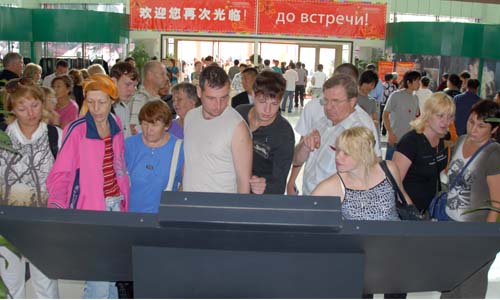|
 |
|
SHOPPING, SHOPPING: Russian tourists read shopping guides at a free trade mall in Suifenhe, Heilongjiang Province. Every day, 8,000-10,000 Russians stay in Suifenhe, with shopping on their schedules (NEWSPHOTO) |
"We want to allow Chinese products to get normal customs clearance without being hurt or hindered by irregularities in customs procedures," Fu said.
In the 1990s, when Russia was in serious short supply of daily necessities, it allowed intermediaries to handle customs clearance for bulk commodities. The intermediaries could usually help the importers clear the customs with tariffs lower than the prescribed levels. Goods entering Russia this way are not given official customs declaration documents. In recent years, Russia has prohibited such irregular clearances.
"Establishing the online electronic transaction platform is a way of adapting to and embracing the Internet and modern communications and trading methods. It can save operational costs for the companies and eliminate their commercial risks," Fu said.
Dongning model
In July 2010, Jinlongchang Garment Co. Ltd. moved from Beijing to Dongning, a neighboring county of Suifenhe and also a land port in Heilongjiang Province. With materials from Beijing, the factory produces semi-finished products in Dongning and then transports them to Russia, where its Russian partners put the semi-finished products together and sell the final products to the Far East and other parts of Russia.
"The pattern of China-Russia cross border processing has advantages that other places don't, and such a practice will attract more companies," said Gao Bo, a manager of the factory.
According to figures from the Dongning county government, since 1990 the county has completed trade volume worth $14 billion, and the port has handled 4.65 million tons of cargo and 5.8 million passengers. In the first seven months of 2010, the trade volume of Dongning totaled $1.05 billion, a year-on-year increase of 56.2 percent. Of this, trade with Russia amounted to $980 million, up 50.8 percent year on year, accounting for 25.2 percent of the province's total trade with Russia.
In terms of product structure, China and Russia are complementary to each other, with China buying resources and primary products and Russia buying light industrial products. In the first seven months of 2010, China mainly exported semi-finished shoes, finished shoes, garments as well as farm and sideline products to Russia while importing raw products, refined oil and polyethylene.
However, Dongning is not satisfied with just being a land port. In recent years, Dongning has initiated a strategy of promoting trade processing. According to information released by the government of Dongning, with imported soybeans from Russia, the county can process 40 million tons of dried bean curd sticks each year and then export them to Russia.
Sun Yongxian, Secretary of the Dongning County Committee of the Communist Party of China, said that there are more than 70 factories for plate materials and furniture using timber imported from Russia. Besides, Dongning is also the country's biggest deep processing base of Russian pine nuts and an important processing base for fish imported from Russia.
An attempt Dongning has made in import and export processing is the China-Russia cross border processing relay. Sun said under such a pattern, Chinese companies produce semi-finished products in China, export them with low tariffs and allow Russian companies to put the semi-finished products together in Russia. The products would then be sold as Russian-made products. This can reduce production costs, avoid sales risks and solve customs irregularities and high import tariffs for finished products entering Russia. Moreover, products assembled in Russia can be registered with Russian trademarks and directly sold through Russian sales channels.
According to figures from Dongning county government, the import tariff rate collected by Russia on finished pairs of shoes is 33 percent, while that on semi-finished shoes is only 10 percent. The import tariff on finished garments is about $9 per km, while that for semi-finished garments is $2.8-$6.1. Therefore, the China-Russia cross border processing relay can reduce the production costs by a large margin.
Sun thinks this pattern can make use of the cheap labor in China and allow the products to enter the Russian market as "made in Russia."
"This can utilize two kinds of advantages on both markets, hence reducing the costs and enhancing the competitiveness of the products," Sun said.
He also said developing the processing industries is also significant to Dongning in that it increases employment and local tax revenues, driving up local economic development in an all-round way.
The next thing Dongning is considering setting up in Russia is marketing networks. "We will enhance brand building and improve the quality of Chinese products to change their image as poor quality goods," Sun said. | 